In its latest projections, the Bureau of Labor Statistics projects the fastest growth in higher-wage occupations that require more education. Healthcare and tech jobs are projected to grow fastest, while sales and office jobs shrink most.
Renewable energy, healthcare, and tech are where the jobs are
Last week the Bureau of Labor Statistics (BLS) released its latest employment projections, for the period 2023-2033. These projections reveal how fundamental shifts could affect the labor market — they are intended to reflect structural changes in labor supply and demand, rather than short-term booms and busts. (See note.) Naturally these projections aren’t crystal balls: they can’t anticipate a recession, pandemic, natural disaster, or geopolitical crisis. But, still, these are well-reasoned, sober projections that suggest how the labor market could evolve.
The jobs projected to grow fastest over the next ten years include two in renewable energy — wind turbine service technicians and solar photovoltaic installers — and several in healthcare and technology. The top ten fastest growing jobs all pay more than the average job, and some pay well over twice the average.
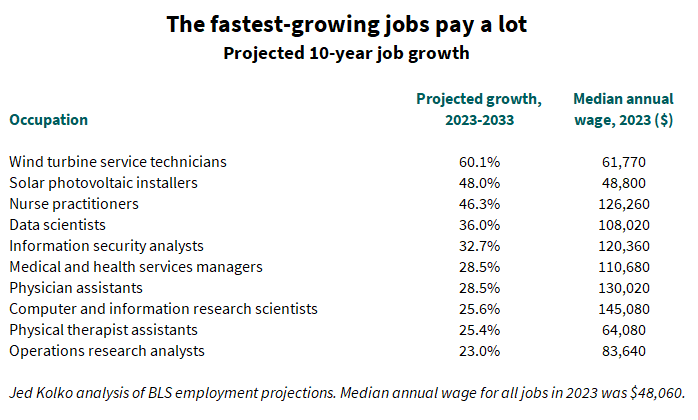
These high-paying, fast-growing jobs aren’t open to everyone, however. According to the BLS, seven of these ten jobs typically require at least bachelor’s degree, and three of those typically require a master’s degree.
Job growth favors high-pay, high-education jobs
It’s not just a few tech and medical jobs: in general, high-pay, high-education jobs are projected to grow more than lower-pay jobs and those requiring less education. The highest-paying fifth of occupations (in other words, the top quintile) are projected to growth 8.9% between 2023 and 2033. Middle- and lower-paying occupations are projected to grow less than 3% over this period. In these latest projections, job growth is more skewed toward the highest-paying occupations than in the last pre-pandemic projection, for the period 2019-2029, which called for fast job growth in both the highest and lowest paying occupations.
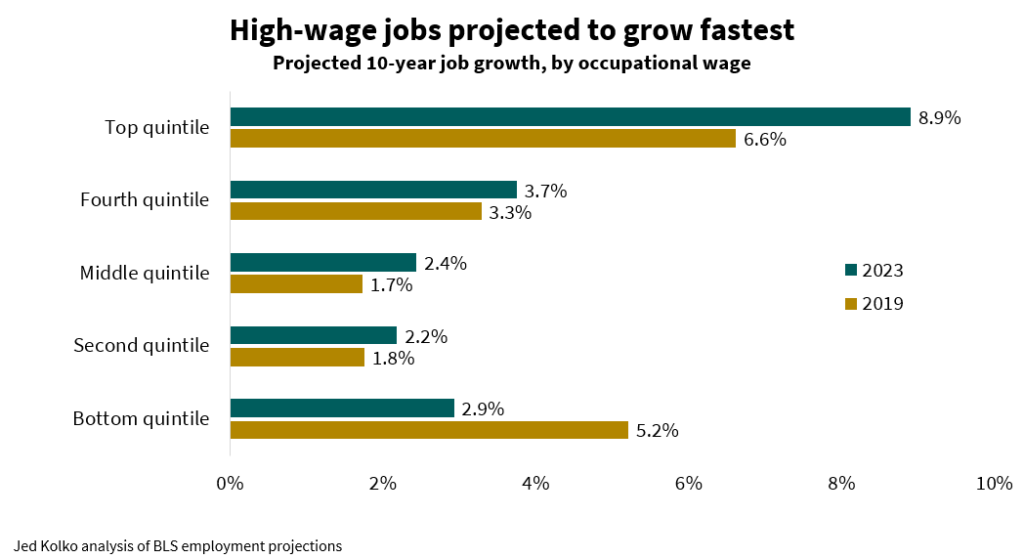
Jobs requiring more education are projected to grow faster than those requiring less: 9.3% for those requiring a graduate degree versus just 2.5% for those requiring a high school degree only and 1.8% for those that don’t require a high school degree. Job growth is more skewed toward jobs requiring more education in the 2023 projection than it was in the pre-pandemic 2019 projection — mirroring the increasing skew toward higher-paying jobs.
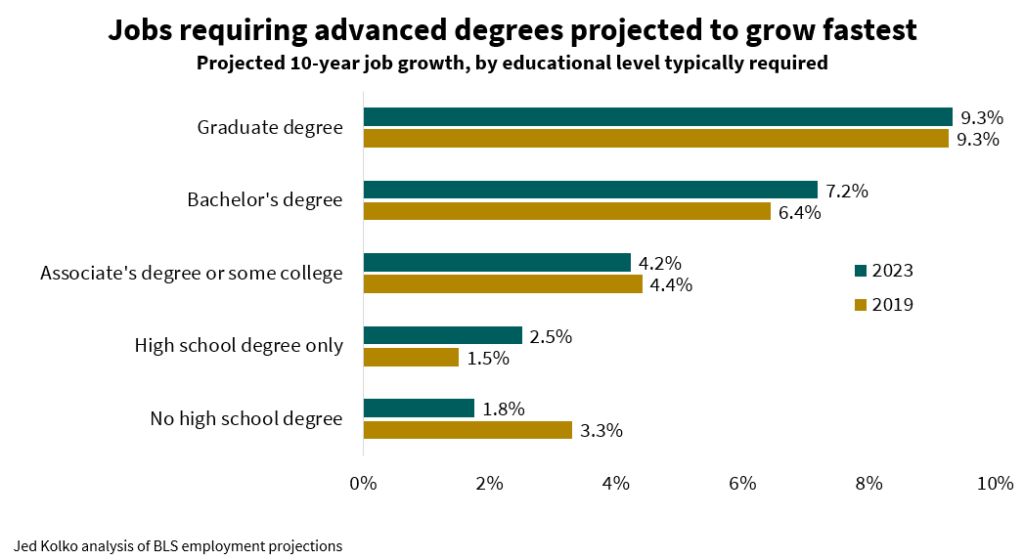
Sector job projections today look similar to pre-pandemic forecasts
Among all occupational sectors, health care and computer and mathematical occupations are projected to grow most. But of 22 sectors, four are projected to show declines in employment. Two of these are goods sectors: production (that is, manufacturing) occupations, and farming/fishing/forestry jobs. However, the two sectors projected to decline most are in services: sales and related occupations, and office and administrative support occupations (like customer service representatives and bookkeeping and accounting clerks).
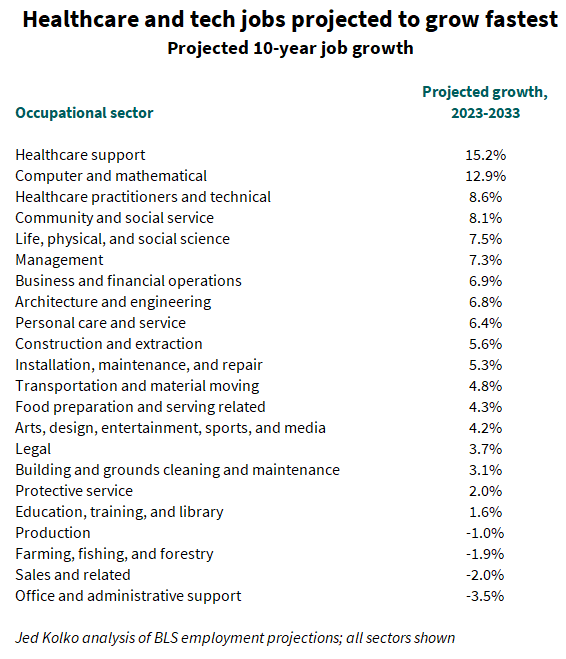
Despite all the upheaval and dislocation of the pandemic, these latest projections are broadly similar to the last pre-pandemic projections in 2019. The four sectors projected in 2023 to grow fastest were the same top four in 2019; the four sectors projected in 2023 to shrink were the same and only four sectors projected in 2019 to shrink.
One of the shifts between the 2019 and 2023 projections is slower growth for food preparation and serving related occupations. These jobs were projected to grow 7.3% over 2019-2029, and only 4.3% in the ten years over 2023-2033. Still, this slower projected growth for 2023-2033 is a sunnier picture for the sector than the alternative pandemic-impacted projection BLS published in 2019. This alternative projection called for a job losses in the food prep sector of 1.6% over 2019-2029 instead of the baseline 2019-2029 projection of a 7.3% gain. This alternative projection assumed long-lasting increases in remote work, declines in in-person food and entertainment, and increases in public health research and spending. Just as the macroeconomy rebounded strongly after the pandemic, with employment and GDP now above the pre-pandemic baseline, jobs that looked most at risk during the pandemic are poised to grow.
What about sales and office jobs? These are projected to shrink over the next ten years, but not because of the pandemic. Both of these sectors were projected to contract in the 2019 baseline projection, too. The ten-year growth projection for sales jobs was -2.0% in 2019 and -2.0% in 2023; for office and admin support jobs, the projection was -4.7% in 2019 and -3.5% in 2023. BLS projections earlier in the 2010s called for growth in these sectors, but by the eve of the pandemic they were already projected to shrink.
Finally, the 1.0% contraction in production jobs in the 2023 projection is an improvement on the 2019 baseline projection of a 4.5% decline. Furthermore, the manufacturing industry — which includes not just production jobs but jobs in a wide range of other occupations too — is projected to grow 0.8% over 2023-2033, after having been projected to shrink 3.5% in the pre-pandemic projection for 2019-2029. Growth of 0.8% in manufacturing is still below the overall economywide projected growth of 4.0% for 2023-2033, which means that manufacturing’s share of national employment would continue to fall over the next decade — but more gradually than in pre-pandemic projections.
Skills demand will shift more toward science, away from fine motor skills
The 2023 projections are the first in which BLS included assessments of how important different skills are in each occupation. For instance, interpersonal skills are very important for counselors, psychologists, and therapists, but not so much for sewing machine operators, refuse collectors, and economists (!). Detail orientation skills are very important for anesthesiologists, nuclear technicians, and air traffic controllers, and less so for models, door-to-door salespeople, street vendors.
Because some occupations are projected to grow faster than others, and different skills are important in each occupation, the occupational projections imply that some skills will grow more in importance than others. Comparing the skill importance ratings of the typical job in 2023 with those of the projected typical job in 2033, science and critical and analytical thinking skills increase most in importance. Customer service and fine motor skills decline in importance, consistent with the projected contraction of production jobs (many of which rely on fine motor skills) and sales and office jobs (many of which require strong customer service skills).
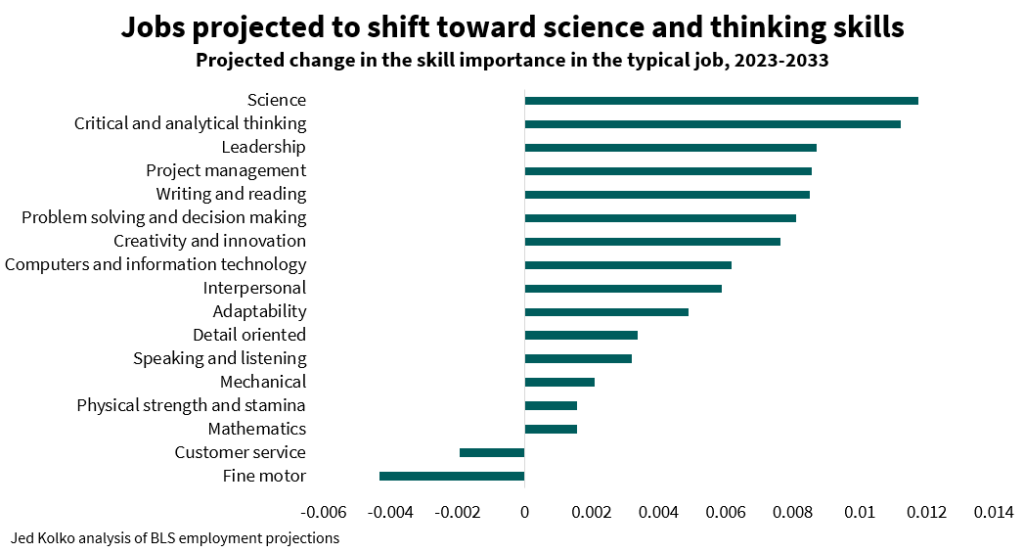
Note: BLS projects employment in industries and occupations based on “long-term structural changes in the economy that are expected to affect the demand for an occupation in each industry.” These include changes to consumer demand, input sourcing, productivity, occupational substitution, and capital/labor substitution. More detail on the structural changes affecting individual occupations is available here.
The skills analysis is the change in the weighted average of skill importance across the detailed occupational distribution in 2023 and 2033.